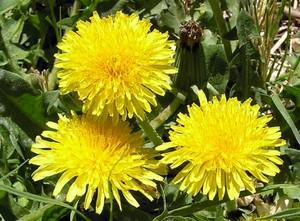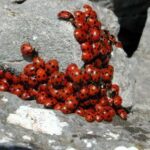Ridding your lawn of dandelions takes patience and persistence, but is not overly difficult. Contrary to what many would have you believe, there is no real need for toxic herbicides. A few dandelions are actually desirable in the spring. Being one of the earliest growers, they attract and provide food for ladybugs and other beneficial insects that help control the damage causing pests later on. Their fleshy taproot helps aerate the soil as well.
If you have a history of very heavy dandelion growth it is easiest to use an application of corn gluten meal. This may be purchased in many nurseries and garden centers, is non-toxic and works by preventing the germination of broadleaf weed seeds. Follow the manufacturer’s directions very early in the season and it will eliminate a good percentage of your problem. A weed burner is also very effective. After burning, tilling the soil and reseeding the grass will give you a fresh start. Once you have them down to a reasonably manageable level, a healthy lawn is quite simply your best defense.
Seed grass heavily in the spring as it begins to grow since good coverage discourages most weeds. One of the most common lawn errors is light, frequent watering. Grass should be watered deeply and infrequently. This encourages the roots to grow deeper into the soil making your lawn more drought and disease resistant.
Mowing often will catch many of the dandelion blooms before they have a chance to make seed and this is the only way they spread. Be sure to set your mower at or above 2″. Most grasses don’t do well if mowed shorter and sickly grass is an open invitation for dandelions and other opportunistic weeds.
When dandelions are noticeably, but sparsely scattered throughout the lawn I have had the best luck with digging or pulling them up. Doing this after a good rain or deep watering will take most of the work out of it. Special long handled diggers and weed pullers are available that make this tedious job much easier. Most hardware store garden centers will carry these and they are well worth the $10 to $30 you will spend!
When you have a problem with dandelions growing in the cracks of sidewalks, gravel and other non-plant areas you have several options. Vinegar (5% solution white vinegar) is very effective as a foliage spray, as well as poured in the crack. Boiling water will also work, as does a weed burner or hand-held propane torch. All of these will work on dandelions in the lawn, but I rarely use them there. Unless you are exceptionally careful they will kill spots of the grass along with the dandelion.
Persistence is the key. Check your lawn a couple of times a week for new dandelion growth, pulling out any you find before they have a chance to bloom. If you do not use chemical herbicides or pesticides, pick the young leaves from the plants you pull and use them in a salad. According to the USDA, raw dandelion leaves contain vitamin C, A and large amounts of beta-carotene. They have a pleasingly mild flavor and are very tender. Dried dandelion root used as a tea is considered to be an excellent treatment for urinary tract infections. It is also effective as a diuretic and, unlike most chemical diuretics, it actually replaces the potassium normally flushed out of the body when these are used.
Eating and medicating your way to a prettier lawn! Who would have ever imagined that?
Fun Facts provided were found at NatureWatch of Canada, a great site fpromoting environmental awareness!







